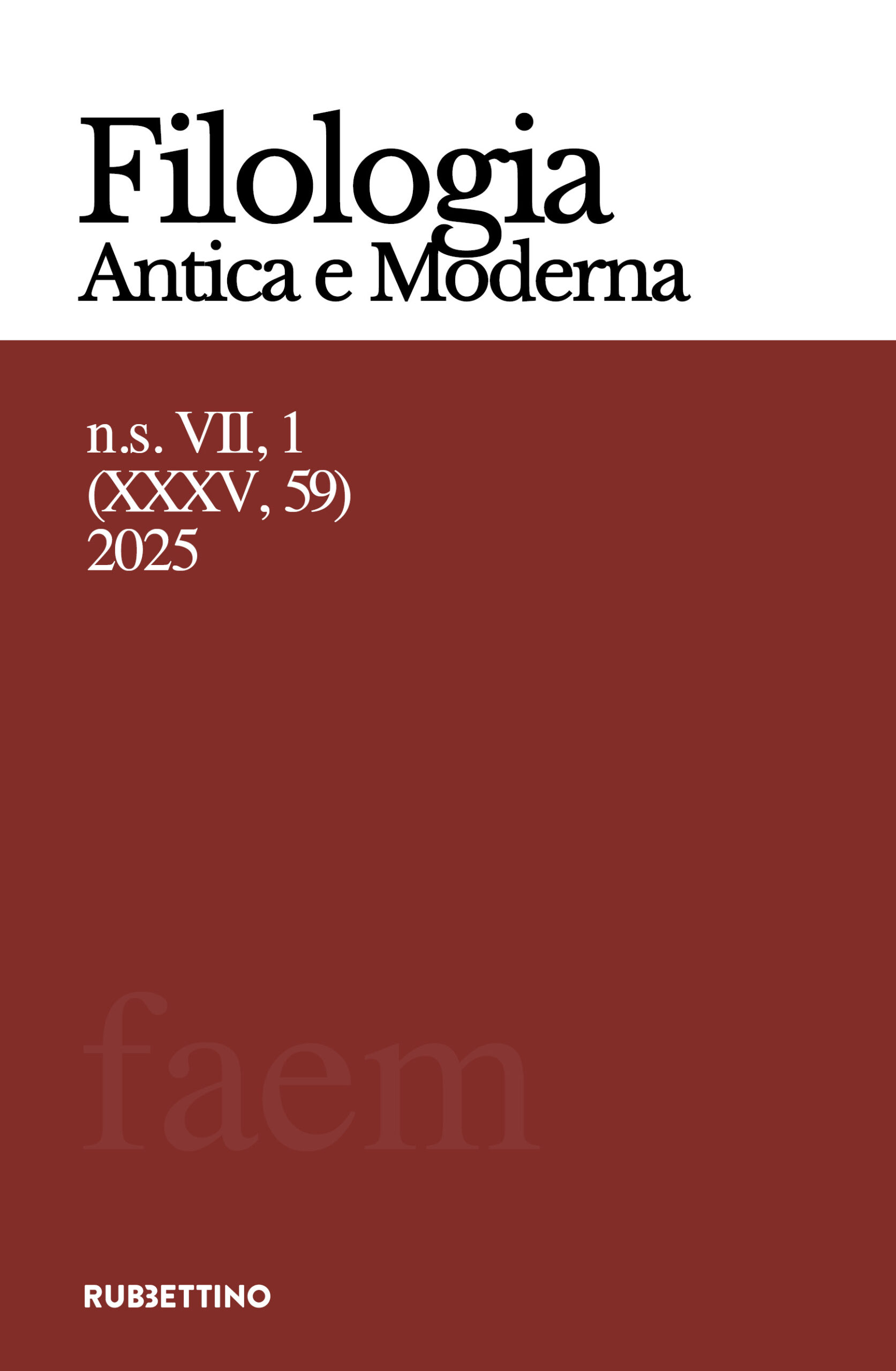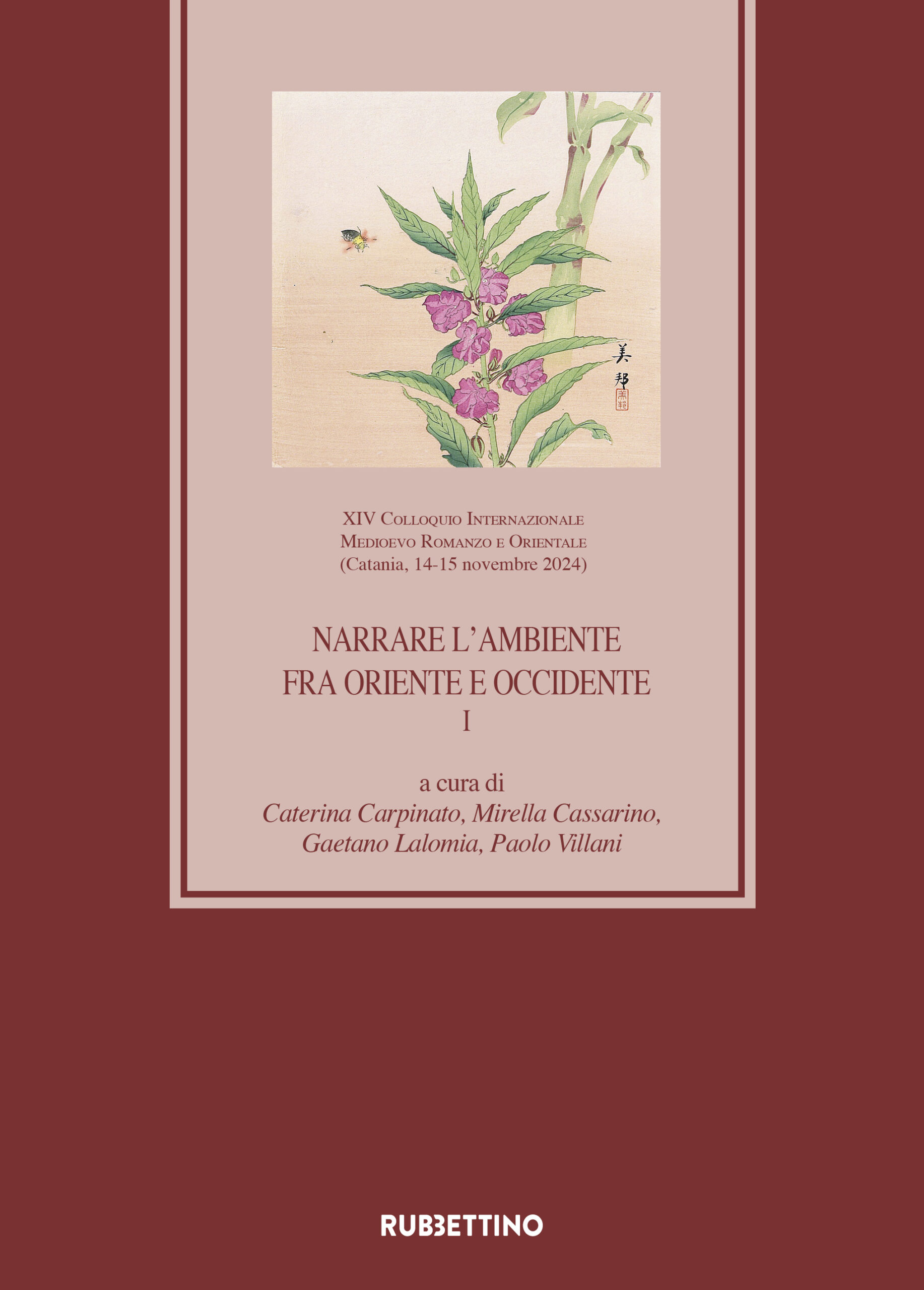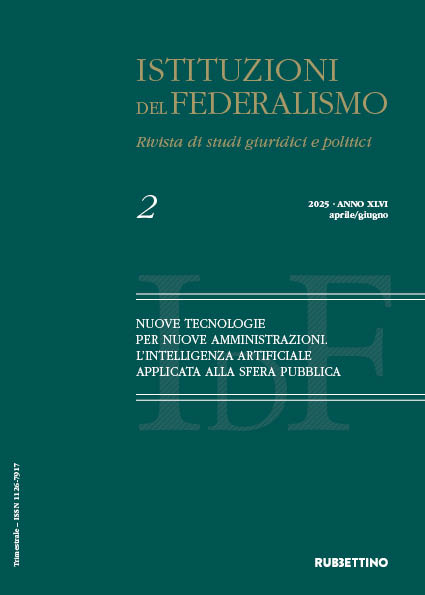Le forme e la storia ns XVIII, 2025, 2
Il corpo nella scrittura delle donne
a cura di Maria Serena Sapegno e Attilio Scuderi
Cartaceo
€14,25 €15,00
Eliana Creazzo
Parlare dal corpo. Donne e scrittura mistica nel Medioevo: il magistero
di Ildegarda di Bingen
Speaking from the Body. Women and Mystical Writing in the Middle Ages: the Teachings of Hildegard of Bingen
The article proposes
Eliana Creazzo
Parlare dal corpo. Donne e scrittura mistica nel Medioevo: il magistero
di Ildegarda di Bingen
Speaking from the Body. Women and Mystical Writing in the Middle Ages: the Teachings of Hildegard of Bingen
The article proposes an investigation into the dimension of the body in
medieval female mystical writing. The analysis focuses on the founding teaching of Hildegard of Bingen (12th century), with her “dualitarian” vision of the human being – integrally and inseparably soul and body in the search for reharmonization with the divine –, which emerges both in works of a prophetic nature and in those of a naturalistic nature. The same category of mystical “vision”, origin and justification of the word and writing, sign of an unmediated relationship between the woman and God, involves the dimension of the body and gives shape to a “total language”, synaesthetic, which is linked to the experience and biography of the subject. In the visionary writings of the 13th century authors, the theme of the closeness between the woman and the divine Other is accentuated, which becomes intimacy of bodies, turning into a relationship of love.
Eleonora Carinci
Il corpo negli scritti delle donne nell’Italia della prima età moderna: Il merito delle donne di Moderata Fonte
The body in Women’s Writings in Early Modern Italy: Moderata Fonte’s the Worth of Women
Humanism and the Renaissance represent, in historiographical reconstruction, the founding moments of modernity. In this period of redefinition of the Western world, particular attention is given to women, as different from men. In this context, women’s bodies became the subject of attention from a medical, cultural and philosophical point of view, in a dichotomous system in which culture and nature took on precise and unambiguous meanings, and in which nature, the senses and the body were associated with something
inferior, negative and “feminine”. At the same time, however, thanks to
a series of favourable cultural and social circumstances, many women had the opportunity to take up the pen and publish their works. But how did these authors relate to their own bodies and to the cultural system that defined and represented them? How did they talk about them in their writings? Did they completely internalise the message conveyed by the dominant culture, or did they talk about it with greater knowledge? In this article, I consider how women’s body is treated in Il merito delle donne (The worth of Women, 1600) by Moderata Fonte, a dialogue in which the author puts on paper seven women talking to each other about their relationship with men and the culture of their time. The women of Merito express women’s points of view on various topics concerning the body, showing an attempt of the author to make closer body and soul.
Claudia Marsulli
Il corpo pubblico dell’aspirante santa. Catastrofi naturali e intercessione femminile nelle Devotioni di Brigida Morello di Gesù (1610-1679)
The public body of the aspiring saint. Natural catastrophes and female intercession in the Devotioni of Brigida Morello di Gesù (1610-1679)
This contribution focuses on the textual dynamics that lead to the elaboration of the “public body” of the aspiring and interceding saint, beginning with recent historiographical attention to the role of saints in modern disaster narratives. The writings of Brigida Morello di Gesù, a seventeenth-century mystic and charismatic woman in Piacenza, reveal how the female oblate body constituted a bridge between God and the entire Christian community, as well as between phenomenal, material reality and the supernatural world of divine will. In particular, the intercessory practices promoted by Brigida during the Rimini earthquake of 1661 demonstrate, on the one hand, the performative
potential of the female oblate body, and, on the other hand, highlight
the significance of female charisms in relation to the autopoietic processes associated with writing.
Carminella Sipala
Fra égarements e affections vaporeuses: raccontare la sofferenza del corpo
Between égarements and affections vaporeuses: recounting the suffering of the body
The Lettres of Mademoiselle de Lespinasse (1732-1776) had considerable success in the 19th century for their proximity to the Romantic feeling of an extreme and painful idea of “amour passion”. But a reading that contextualises them in contemporary conventual writing and medical discourse, and at the same time in the literary and philosophical space of the siècle des Lumières, allows us to grasp in this epistolary the sensist and materialist perspective that Mademoiselle de Lespinasse deploys in the representation of the female body and, above all, a new way of questioning herself, of perceiving her own existence, of circumscribing it starting from her own physicality, her own embodied boundaries. So that the body, freed from all mysticism and the millenary dualism that opposed it to the soul, can finally assert itself as the source of an early, in western culture, self-awareness.
Chiara Maciocci
«Come una zanzara verso la luce». Limiti materiali e corpi porosi
nella poesia di Annette von Droste-Hülshoff
«Like a Mosquito towards the Light». Material Limits and Porous Bodies in the Poetry of Annette von Droste-Hülshoff
This paper examines Annette von Droste-Hülshoff ’s (1797-1848) nature writing from a perspective that has received little attention so far: the interplay between her ecological poetics and her ambivalent representations of gendered embodiment. While rediscovered by feminist criticism in the 1970s and more recently recognized by German ecocriticism for her consistent decentering of the human subject, Droste remains virtually unknown in the Italian academic and publishing context. I argue that her Naturlyrik not only displaces the human but also foregrounds the materiality of the (female) body as both a limit and a sensory threshold to the natural world. Drawing on new materialist ecofeminist concepts such as trans-corporeality (Alaimo), intraaction (Barad), and porosity (Tuana, Iovino), I propose a new reading of embodiment in Droste’s work. This approach reveals how her poems place the body and the material specificity of the lyrical subject at the center, while simultaneously dissolving boundaries between body and environment – a porous becoming that destabilizes hierarchical relations and gestures toward alternative forms of coexistence and kin-making (Haraway).
Paola Ferretti
«Da giovani il corpo è abito di gala…». Note sulla fisiologia in Marina Cvetaeva
Notes on Physiology in Marina Tsvetaeva
In the work of Marina Tsvetaeva (1892-1941) consideration of corporality spans from detailed and quintessential representation of the physical sphere to the most radical anti-body professions: we can find a complete identification of poetry with blood as expressed in her lyric I opened my veins. Unstoppably, published in 1934, or, on the other side, an imagined ascension in which her body progressively loses gravity and abandones all the five senses, as in her masterpiece entitled Poem of the Air, dated 1927. Tsvetaeva’s prose is disseminated with meditations and aphorisms about the body. Particularly relevant is her use of the notion of corporality as applied to the configuration of the identity of the Poet within the cycles of verses written between 1916 and 1931 and devoted to other great Russian poets (Alexander Blok,
Anna Akhmatova, Vladimir Mayakovsky, Alexander Pushkin). The essay explores how her attitude on this issue varies from poet to poet and how it acts as part of a process of self-definition.
Martina Censi
Poetica del trauma e riscrittura della storia in due romanzi di Mahā Ḥasan (Siria)
Rewriting history through a poetics of trauma in two novels by Mahā Ḥasan (Syria)
Over the twentieth century and up to the present day, women novelists
in the Arab world have moved from the margins to the center of the literary field. This shift is reflected in the languages and style of their writing, which has moved from a focus on the intimate universe and personal experience – where “the personal was political” – to the collective and public dimension. The history of Arab women’s marginalization at the heart of patriarchal societies affects their view of the world and their writing, which gives pride of place to the representation of various forms of trauma that often pass through
the body. Based on some reflections about the relationship between women’s writing, bodies and trauma, and the rewriting of history, I wish to turn attention to the work of Syro-Kurdish novelist Mahā Ḥasan, through a comparative analysis of two of her latest novels about the Syrian revolution. In Ṭubūl al-ḥubb (The Drums of Love, 2013) and Mītrū Ḥalab (A Subway to Aleppo, 2016), Mahā Ḥasan focuses on two different phases of the upheaval of the political context in Syria after 2011, from the point of view of a Syrian woman, exiled in Paris. Exile and war intersect and are expressed through a “poetics of trauma” that aims to actively involve the reader in the Syrian context. My contribution will aim to highlight the narrative, stylistic and linguistic choices that Mahā Ḥasan puts in place, in these two novels, to elaborate her own “poetics of trauma” by placing them in dialogue with her positioning as a woman writer in exile.
Sara De Simone
«Comme un enfant qui bougerait en moi»: note su creatività e metafore del materno nello scambio fra alcune artiste del Novecento
«Comme un enfant qui bougerait en moi»: notes on creativity and maternal metaphors in the exchange between some 20th century women artists
Literary creation has often been represented through images related to female fertility, childbirth, and maternity. Male authors were the first to make extensive use of these metaphors. But what happens when these images are used by women? How do these representations change? And, specifically, what happens when these bodily metaphors – gestation, childbirth, breastfeeding – are used in an exchange between women? This article attempts to examine some images of the creative/maternal body used in the dialogue between 20th century writers and artists linked by an emotional/friendly bond, including Virginia Woolf and Vanessa Bell, Violette Leduc and Simone de Beauvoir, and Elsa Morante and Natalia Ginzburg.
Martina Benigni
“Fiumi mi percorrono”: poesia cinese contemporanea e scrittura del corpo nei versi sdraiati de Le Flâneuse
“Rivers Run Through Me”: Contemporary Chinese Poetry and Body Writing in the Lying Verses of the Flâneuses
This paper aims to disclose new representations of women’s bodies in
contemporary Chinese poetry through the analysis of Tangping ji 躺平集 (Lying flat), a brief poetry collection published on WeChat (Weixin 微信), by the all-female poetry collective e Flâneuses (Chengshi manyouzhe 城市漫游者). To better understand the implications of a liquid, lying body, as depicted in the group’s poems, this exploration draws on Adriana Cavarero’s Inclinations: a Critique of Rectitude (first released in Italian in 2013), which proposes alternative bodily postures as new ontological frameworks. By engaging Cavarero’s theory of the inclined body, this study investigates how the lying flat body in the poems resists patriarchal, rational, and hierarchical structures traditionally associated with verticality. This work is an experimental
mediation between two worlds which, despite cultural differences, seem to share the reimagining of bodily geometry as a site of resistance against the patriarchal-vertical social order. The bridge built here might also be sustained by the fact that tangping is, first of all, a social expression of dissatisfaction with the capitalistic system erected on the laws of hierarchical verticality, oriented towards individualistic social advancement, contrary to the idea of humanity as relational shared by Cavarero and the Flâneuses.
Mariangela Masullo – Maria Elena Paniconi
The Body in Nawāl al-Sa‘dāwī’s Writing Practice Between Fiction
and Science Communication: Imra’tāni fī Imra’ (1975, Two Women in One, 1985) and Al-Mar’a wa-‘l-Jins (1969, Woman and Sex) as case studies
This study examines the representation of the female body in Nawāl al-
Saʿdāwī’s literary and scientific work, focusing on her novel Imra’tāni fī Imra’ (1975, Two Women in One, 1985) and her non-fictional feminist-medical text Al-Mar’a wa-‘l-Jins (1969, Woman and Sex). Drawing from feminist theory, particularly the concept of “embodied writing” by Luce Irigaray and Hélène Cixous, the paper explores how al-Saʿdāwī subverts patriarchal narratives by re-inscribing female corporeality as a site of resistance, knowledge, and subjectivity. Through the use of literary tropes connected to the sensibility of the transnational difference feminism, and through clinical discourse, she challenges
the ideological and epistemological frameworks surrounding female
anatomy, sexuality, and menstruation, revealing the body as a key battleground for feminist critique. The article also interrogates the hybrid nature of al-Saʿdāwī’s prose, blending fiction, autobiography, and medical science to dismantle cultural taboos and promote a transnational feminist epistemology.
Concetta Maria Sigona
Il corpo nella scrittura di Mary di Michele: Debriefing the Rose
The Body in Mary di Michele’s Writing: Debriefing the Rose
Poet and writer Mary Di Michele, an Italian-Canadian writer, explores
the theme of the body, a symbol of a vulnerable identity in which suffering and desire appear as central elements of her writings. Di Michele, in her prose and poetry, writes about the relationship between the body and memory, which contains both personal and cultural experiences that define and characterize the individual. The body in Di Michele’s writing represents a bridge between different cultures and languages. It represents a means of expression and at the same time repression both within the personal sphere and in universal
gender dynamics as she addresses the most intimate issues of the body,
such as femininity, sexuality and power. An emblematic model of the theme of the body can be found in her book of poems Debriefing the Rose, (1998), within which the body is explored intimately and directly and is a fundamental element of self-discovery and questioning of existence. The body is therefore both a source of knowledge and a repository of our most intimate truths and, it is through the act of “debriefing” that Di Michele pushes towards a fragile and resilient confrontation of love and the self.
Anita Fabiani
Il corpo, le cose (a proposito di Una palabra tuya)
The Body, the things (about Una palabra tuya)
Sectioned, stigmatised, hypergenitalised and available only to a mechanical sexuality: this is how Elvira Lindo narrates, in Una palabra tuya (2005), the ‘male’/‘female’ body, while remaining trapped in a monological, reifying descriptivism. This is evidence by Encarnación (the mother of Rosario, the protagonist), a character whom I will focus on in these pages precisely because she is exemplary.
Sara Carlesimo
Il corpo del testo
The body of the text
Elena Ferrante’s literary work has been the subject of extensive critical
analysis for its highly innovative contributions to various themes related to feminism and gender studies. Much attention has been paid to her detailed representation of women’s life experiences and her use of relational storytelling. This narrative approach represents Ferrante’s response to the literary egocentrism of the Subject in the patriarchal tradition, who tells a story based solely on his own perspective and dominant position, universalizing his experience. However, little attention has been paid to the role the body plays in Ferrante’s narrative as a signifier inseparable from the definition of a human
being, in accordance with her explicit critique of the system of thought that regards it as merely a part of the individual. In this perspective, the present article aims to highlight the importance of the theme of the body in Ferrante’s narrative, alongside and in relation to the other themes mentioned above. In the quadrilogy My Brilliant Friend, the revaluation of the body, especially in its female expressions, makes it an integral part of the narrative, together with the inner lives of the protagonists and the events described. Elena and Lila are participants, with their bodies – and not independently of them – in the relational storytelling mentioned earlier. The regained awareness of embodiment culminates in the extraordinary materiality of motherhood, the narrative of which completely revolutionizes patriarchal and thanatological thought, shifting the focus from the centrality of death to the evermiraculous event of birth.






